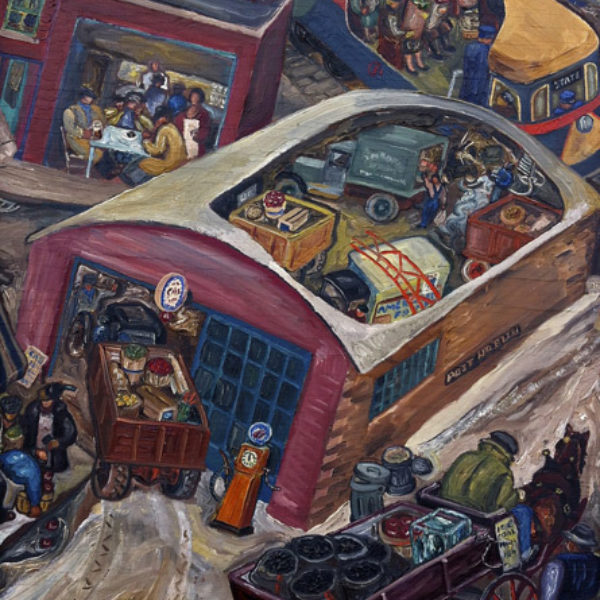Adrian Troy
b. 1901, Hull, England - d. 1977, Memphis, TN
The son of an English father and a French mother, Adrian Troy was born in Britain but moved to Bordeaux in 1907, where he attended high school, university, and the École des beaux-arts de Bordeaux. Troy later wrote that his “continental upbringing” provided him with “a somewhat unorthodox background,” one that sparked interests in travel and art. Following a trip to the West Indies in 1916–17, Troy spent five months each year in East Africa between 1917–21 and a year in West Africa from 1921–22, before immigrating to the United States in 1922.
Although all of these experiences influenced his career, Troy recalled with “complete certainty” that the beginning of the Federal Art Project in 1935 was seminal in his development as an artist. He worked for the Easel and Graphics Division of the Illinois Art Project (IAP) where, among other projects, he produced woodcut illustrations for Federal Writers’ Project books such as Idaho Lore (1939). Troy chronicled a history of black contributions to American life in his illustrations for Cavalcade of the American Negro (1940), published by the Illinois Writers’ Project in honor of the American Negro Exposition in Chicago in 1940. Like many WPA artists, Troy embraced subjects drawn from daily life in his prints as well as in his watercolors and oil paintings. His Street Level Crossing, a busy street scene, for example, was described as “humorous and easy” and praised for its “fresh and clear” color when shown in “Art for the Public,” a 1938 exhibition of WPA art at the Art Institute of Chicago.
The oil painting in the Friedman collection, Untitled (Street scene with cutaway interiors), presents a bustling city market district on a snowy winter day. In the foreground, trucks and horse-drawn wagons, their beds brimming with produce and other wares, approach a crowded garage or gas station, which seems to serve as a distribution hub for the neighborhood. To the left, diners bundled in winter coats and hats gather about a table in a small café, while a large blue and yellow streetcar plunges dramatically across the scene in the background. Troy heightened the sense of movement and activity in the painting through the use of a high vantage point, a radical distortion of perspective, and cutaway views of the buildings and streetcar that reveal the crowded scenes within. These compositional devices, along with the heavily outlined figures and bold use of color, result in an expressive, painted surface that hums with the rhythms of city life. The painting bears striking similarities to Troy’s woodcut Produce Market District in Chicago (1930/43, Art Institute of Chicago), suggesting that his printmaking and color work may have influenced one another.
During his years in Chicago, Troy was an active member of the American Artists Congress, the Chicago Society of Artists, the United American Artists of Chicago, and the South Side Community Art Center, and showed his work in a number of these organizations’ group exhibitions. He also exhibited his at the Art Institute of Chicago between 1938 and 1950, the New York World’s Fair in 1939, the San Francisco Museum of Art, and the Whitney Museum of American Art. Additionally, Troy served on the faculty of the School of the Art Institute of Chicago, where he taught wood engraving in the 1950s and 1960s. Troy’s woodcut prints are represented in a number of important collections in the United States, including the Art Institute of Chicago, the Illinois State Museum, the Metropolitan Museum of Art, and the Smithsonian American Art Museum.
Patricia Smith Scanlan
References
“Biographic Data.” Typescript. Adrian Troy Pamphlet File P-21767. Ryerson Library, Art Institute of Chicago.
Falk, Peter Hastings, ed. The Annual Exhibition Record of the Art Institute of Chicago, 1888–1950. Madison, CT: Soundview Press, 1990.
Falk, Peter Hastings, ed. Who Was Who in American Art 1564–1975: 400 Years of Artists in America. Vol. 3. Madison, CT: Soundview Press, 1999.
Gardner, Albert TenEyck. “Art for the Public.” Magazine of Art 31 (September 1938): 526–33, 550.
Illinois State Museum. “The Works Progress Administration (WPA) Collection: Brick Laying, Adrian Troy.” Illinois State Museum Collections Online. www.museum.state.il.us/ismdepts/art/WPA/gallery.html?RollID=roll03&FrameID=Troy_Bricklaying (accessed September 15, 2013).
Mavigliano, George J., and Richard A. Lawson. The Federal Art Project in Illinois, 1935–1943. Carbondale and Edwardsville: Southern Illinois University, 1990.
Misc. references for Adrian J. Troy and Jean Adrien Troye on Ancestry.com (immigration, census, draft registration cards, etc), accessed September 26, 2013.
“Notes on Art and Artists.” Chicago Tribune. March 18, 1963.
Yochim, Louise Dunn. Role and Impact: The Chicago Society of Artists. Chicago: Chicago Society of Artists, 1979.
